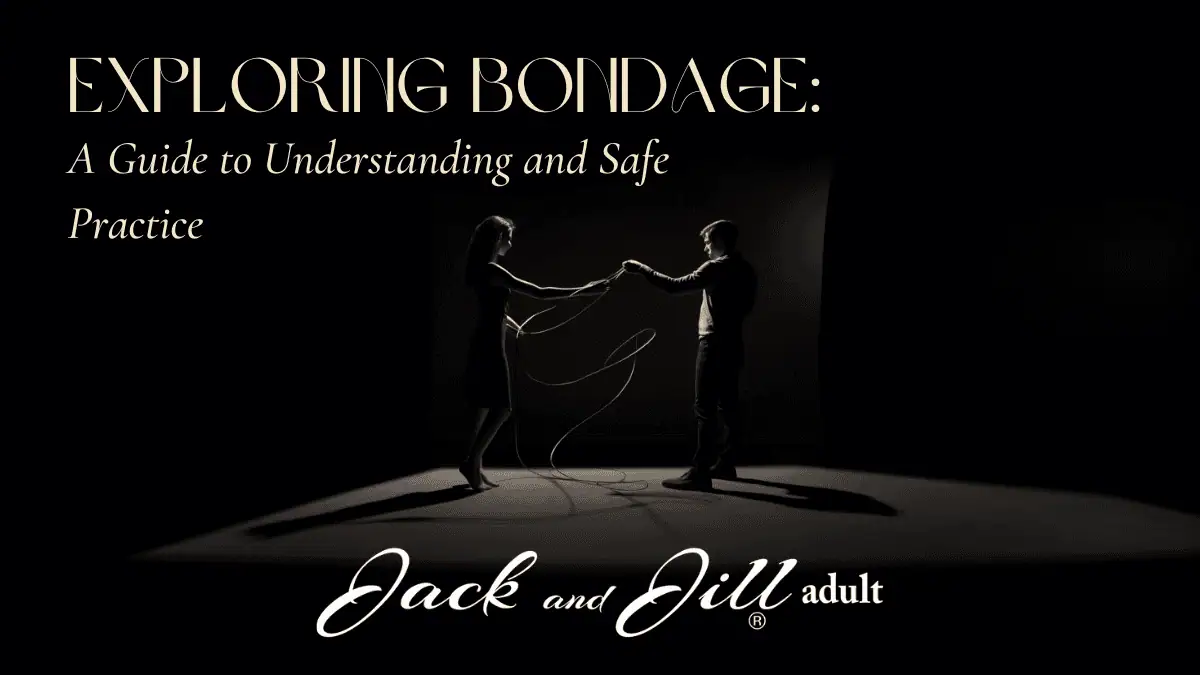
Exploring Bondage: A Guide to Understanding and Safe Practice
Are you wondering how to navigate the world of bondage? This guide delivers a concise exploration of safe, consensual practices within the broader BDSM spectrum. Discover the essentials of responsible restraint, understand the power dynamics at play, and learn about the gear that makes bondage both safe and exhilarating. Whether you’re taking your first steps or looking to refine your techniques, our insights help build a foundation for enriching experiences rooted in trust and mutual satisfaction.
Key Takeaways
- Bondage in BDSM circles involves consensual physical restraint to enhance sexual pleasure, exploring power dynamics, psychological stimuli, and trust between partners while incorporating various intricate practices like Japanese Shibari and Western adaptations.
- Consent and communication are paramount in bondage, involving continuous consent through safewords, establishing clear boundaries, practicing aftercare, and adhering to safety principles like SSC and RACK to ensure ethical and safe experiences.
- Effective bondage practices range from beginner-friendly techniques using simple restraints like cuffs to more advanced forms such as body harnesses, requiring careful consideration of materials and safety, alongside the psychological interplay of trust, vulnerability, and power exchange.
Exploring the Intricacies of Bondage in BDSM

Bondage, derived from Anglo-French and Anglo-Latin origins, refers to the practice of being physically restrained. However, in the landscape of BDSM, it takes on a more profound meaning. It involves consensually tying, binding, or restraining a partner, which may not necessarily imply sadomasochism but plays a significant role in the power dynamics between participants. The allure of bondage sex lies in its combination of psychological and physiological stimuli, providing an erotic power play that heightens excitement and fulfills sexual fantasies.
Yet, BDSM activities are more than just physical restraint. They’re a dance of dominance and submission, a game of control and surrender, where the ties that bind are as much mental as they are physical. It’s an exploration of self and others, where the act of binding or being bound can unlock new depths of personal and shared experience.
We’ll further explore these complexities, focusing on the essence of restraint, the dynamics of dominance and submission, and the cultural influences that shape bondage practices.
The Essence of Restraint: Tying Up Sexual Fantasies
Bondage, as a form of sexual activity, uses physical restraint as a conduit to enhance pleasure. Restricting a partner’s movement creates a tantalizing sense of anticipation and heightens sensory awareness, turning every touch, every whisper, into a potent source of arousal. The art of restraint in bondage is an intricate dance, employing a variety of devices such as:
- Simple ropes
- Handcuffs
- Spreader bars
- Bondage frames
These tools and equipment can be used to explore and enhance your bondage experiences.
Using a tie to bind up one’s partner, having them at your mercy or being at theirs, is a compelling element of many sexual fantasies. For example, when I first considered tying up my wife, it wasn’t about control—it was about deepening our connection, exploring fantasies together, and building trust in a new way. It transcends the mere act of binding to encompass:
- The thrill of power dynamics
- The intimacy of trust
- The liberation found within the confines of restraint
- Testing limits
- Exploring desires
- Deriving pleasure from the enticing tension of being tied.
Defining Roles: Dominant and Submissive Dynamics
At the heart of bondage, and indeed most BDSM activities, lies the dynamic between the dominant and submissive roles. Known as D/s relationships, these power exchanges fulfill emotional and/or sexual desires, creating a thrilling dance of control and surrender. The dominant’s role is to exert control, while the submissive’s role is to willingly surrender control. Both roles seek satisfaction through this power play, finding pleasure in the push and pull of dominance and submission.
However, the scenario isn’t always cut and dried. There is some flexibility within D/s dynamics, as individuals sometimes opt to swap roles. These participants, known as ‘switches’, relish the fluid power exchange and the versatility of experiencing both sides of the spectrum. The continual ebb and flow, the oscillating dance of power and surrender, is what lends such intrigue to the dynamics of dominance and submission in bondage.
Cultural Influence: From Japanese Shibari to Western Practices
The practices of bondage are as diverse as the cultures that influence them. From the intricate artistry of Japanese rope bondage, known as Shibari, to the adaptations and innovations of Western practices, the world of bondage is a rich tapestry of cultural influences. Shibari, with its intricate rope work and emphasis on connection, has influenced Western bondage practices, contributing aesthetic elements that have been incorporated into Western styles and techniques.
While Shibari has had a significant influence on the visual and aesthetic aspects of Western bondage, Western practices often prioritize restraint for other sexual activities, not emphasizing the aesthetics of the rope work as much as Shibari does. In addition to Shibari, Western bondage practices have drawn on a variety of cultural elements, including European medieval dungeons, Victorian corsetry, and the use of modern industrial materials, resulting in a blend of historical and contemporary bondage expressions. This fusion of influences has created a versatile and evolving world of bondage that continues to intrigue and allure.
Consent is Key: Navigating Safety and Communication in Bondage
In the world of BDSM, consent is the cornerstone of every encounter. It’s a participant’s permission for certain acts or types of relationships, where such consent signifies an informed, voluntary decision essential for safe and responsible play. Consent in BDSM is not a one-time agreement but is revocable at any time using a safeword. This emphasizes the need for ongoing consent and its role in maintaining safe play.
Trust and open communication are vital in a D/s dynamic, requiring partners to negotiate and consent to all activities beforehand. This ensures a shared understanding and safety, creating an environment where individuals can explore their desires without fear or hesitation. Understanding and respecting physical and emotional boundaries is crucial for a safe and enjoyable bondage experience. Partners are encouraged to discuss their limits prior to engagement, creating a shared understanding of boundaries and expectations.
Establishing Boundaries and Safe Words
Before immersing oneself in the fascinating world of bondage, establishing clear boundaries and safe words is crucial. Clear communication and negotiation of boundaries prior to engagement in BDSM play are essential for establishing a healthy D/s dynamic. Discussing potential risks and agreeing on a course of action in case of adverse scenarios contributes to a well-prepared and safe experience.
Safe words are pre-established verbal cues used to communicate the need to pause, slow down, or stop the play. They’re critical for safety in BDSM, ensuring that consent can be clearly and immediately withdrawn during play. Selecting a safe word that is distinct and unlikely to be mistaken for play-related communication is crucial for its effectiveness. When verbal communication is not possible, non-verbal signals or safe words should be established to maintain safety.
Consent within BDSM is specific and negotiated, limited by duration and content, allowing participants to express their boundaries and engage only in activities they feel comfortable with. Trust is paramount for exploring edgier aspects of BDSM, such as:
- consensual non-consent
- bondage and discipline
- dominance and submission
- sadism and masochism
These activities rely heavily on established and honored boundaries.
Aftercare: The Post-Bondage Consideration
Aftercare holds a fundamental place in BDSM, especially within a D/s dynamic, as it is designed to ensure the well-being of the involved partners following the intensity of a scene. Components of aftercare may include:
- Providing physical comfort and hydration
- Offering emotional support
- Processing the scene through discussion
- Mitigating effects such as soreness, exhaustion, or disorientation
The necessity for aftercare is contingent on the intensity of the BDSM scene, yet understanding and preparing for it is indispensable for the safety and comfort of all participants. Aftercare extends beyond immediate post-scene care, including ongoing communication and care between partners to continue supporting each other’s emotional equilibrium after the initial aftercare period.
SSC vs. RACK: Understanding Safety Principles
Navigating the world of bondage safety involves understanding key principles such as SSC (Safe, Sane, Consensual) and RACK (Risk-Aware Consensual Kink). Both of these principles aim to ensure ethical participation in BDSM activities, although they approach safety in different ways. SSC prioritizes safety, sanity, and mutual agreement in activities, while RACK acknowledges the inherent risks in some BDSM activities and focuses on informed consent and awareness of these risks.
RACK promotes explicit conversations about potential scenarios in a scene, ensuring all parties have a comprehensive understanding of the risks involved. This process minimizes misunderstandings by explicitly communicating personal boundaries and acceptable levels of risk before engaging in BDSM play. Beyond SSC and RACK, other frameworks like PRICK (Personal Responsibility Informed Consensual Kink) also stress personal agency and informed consent, with each model highlighting different aspects of safety and ethics.
Bondage Techniques and Equipment
Bondage is an art form with a vast array of techniques and equipment. Some common techniques and equipment used in bondage include:
- Single-column ties
- Double-column ties
- Stocks
- Bondage beds
- St. Andrew’s crosses
The type of restraint chosen, particularly when involving a body part, can significantly influence the dynamics of power and control, as well as the sensual and psychological experience for women.
Regardless of whether you’re a novice discovering the world of bondage or a seasoned practitioner aiming to broaden your skills, gaining an understanding of the diverse techniques and equipment available is vital. The key to a fulfilling bondage experience lies in understanding the dynamics of restraint and learning to use different techniques and equipment to heighten pleasure and control.
Starting Simple: Wrists and Ankles
For those just starting out, simple wrist and ankle restraints make a great entry point. Cuffs made of materials like leather or neoprene are popular for beginners due to their adjustable straps and quick-release mechanisms, enhancing safety and ease of use. Velcro bondage restraints are also recommended for beginners because of their adjustability and ease of removal.
However, safety should always be the priority. Here are some tips to ensure safety when using restraints:
- Apply restraints loosely, especially around joints, to avoid nerve compression.
- Avoid using bulky knots that could dig into the skin.
- Pull ropes gently or use a hand as a buffer between the skin and the rope during faster movements to prevent rope marks and burns.
Advanced Restraints: Body Harnesses and More
As you accumulate more experience and confidence, you might be inclined to delve into more advanced restraints such as body harnesses, waist belts, and thigh cuffs. These forms of restraints are more complex and require a higher level of skill to ensure safety and effectiveness. Special attention to the submissive’s body position and weight distribution is crucial for safety when using suspension cuffs.
It’s essential to approach advanced restraints with care and preparation. Always ensure that you’re comfortable with the techniques and equipment you’re using, and never rush into a situation that you’re not ready for. Remember, the goal of bondage is to enhance pleasure and connection, not to put yourself or your partner at risk.
Selecting the Right Materials
The selection of materials for bondage gear can play a significant role in shaping the experience. Depending on the style of bondage, the following materials are commonly used:
- Ropes made of natural fibers such as jute and hemp are commonly used in Japanese Shibari.
- Softer materials like cotton, silk, and bamboo are favored in Western practices for their comfort and strength.
- Silicone and medical-grade stainless steel are preferred materials for bondage gear because they are durable, body-safe, and easy to clean, mitigating risks of allergic reaction or injury.
Handcuffs used for bondage should have adjustable sizing and a quick-release mechanism to ensure a good fit and the ability to remove them quickly for safety and comfort. For mouth gags, materials such as silicone, rubber, or other breathable options are recommended and should include a quick-release feature to ensure the safety and comfort of the wearer.
The right materials can significantly enhance your bondage experience, so take the time to choose wisely.
The Psychological Play of Bondage

Bondage entails more than just physical restraint; it involves the psychological interactions that take place during these acts. The deep sense of trust required between partners can create a powerful emotional connection, making activities like power exchange not only thrilling but also intimate. This psychological dimension of bondage enables both dominant and submissive partners to psychologically empower themselves by exploring and expressing different aspects of their personality and sexuality.
The experience of restraint in bondage can provide the following benefits:
- Heightened sensations
- Increased awareness of the environment and internal feelings
- Inner freedom and peace
- Therapeutic release from the pressures of daily life
This heightened awareness, akin to an active meditation, offers a therapeutic release from the pressures of daily life.
As we delve further into the psychology of bondage, we’ll explore the pivotal role of trust and vulnerability, the liberating release from reality, and the exciting dynamics of power exchange.
Trust and Vulnerability: The Mental Bind
Trust within BDSM relationships paves the way for the safe exploration of vulnerabilities, fostering stronger bonds and more intense sexual encounters. The sense of freedom within restraint in BDSM is linked to the trust that partners will not exploit vulnerabilities outside of the consensual scene. Restraint in bondage provides a release from the burden of decision-making and responsibility, allowing for reduced stress and the ability to fully engage in the present moment.
The psychology behind bondage indicates that, for some, the relinquishment of control allows for emotional freedom, leading to a deeper connection with oneself and others. For some, the act of submitting in a BDSM context is a form of psychological release that allows them to let go of everyday control and experience a sense of freedom.
This deep trust and vulnerability in bondage can offer participants a break from societal pressures and the overwhelming sense of intangible entrapment experienced in everyday life, making BDSM not just a sexual activity but a form of emotional release.
Release from Reality: The Freedom Within Restraint
Engaging in bondage can provide a cathartic and liberating experience, potentially offering therapeutic emotional release. Within the confines of restraint, individuals can discover new aspects of themselves, their desires, or their capabilities. This release from reality provides a space for personal growth and self-exploration, enabling individuals to expand their boundaries and deepen their understanding of themselves and their desires.
This sense of liberation does not come without trust and consent. The freedom within restraint is based on the understanding that one’s boundaries will be respected, that the power exchanged is consensual and that the experience is within the agreed-upon limits. This trust, this consent, is what allows the freedom within restraint to exist and thrive.
Power Exchange: Playing with Control
Power exchange serves as a crucial element in the psychological dynamics of bondage. Psychological restraint is a form of control in bondage without physical restraints, requiring the submissive to hold certain positions or obey commands. The power exchange in bondage facilitates a psychological space known as ‘Domspace’ for dominants and ‘subspace’ for submissives, deepening the experience of control and surrender.
Bondage involves an intricate interplay of aggression, control, and sexual arousal, which can lead to a psychological entanglement within the dynamics of power exchange. In BDSM relationships, the dominant partner has control over the submissive partner, which can involve setting rules and administering discipline. The thrill of this power exchange, the intricate dance of dominance and submission, is what makes the psychological play of bondage so enticing and exhilarating.
Setting the Scene: Creating Your Bondage Experience
Crafting the ideal bondage experience extends beyond sex toys and grasping techniques and safety principles; it involves setting the scene and cultivating an environment that elevates the experience. Setting the right ambiance and atmosphere is critical for creating the desired bondage experience. Some couples enjoy tapping into roleplay or power dynamics that blur the line between watcher and performer, perfect for the inner voyeur exhibitionist who finds thrill in being both observed and exposed. Choose the color and style of the room carefully, as it can significantly influence the mood. Earth tones offer a calming effect, while bold colors induce excitement. Here are some tips to help you set the scene:
- Choose the color and style of the room carefully, as it can significantly influence the mood. Earth tones offer a calming effect, while bold colors induce excitement.
- Incorporate decorative elements like candles, incense, or Japanese-inspired décor to further enhance the atmosphere.
- Soft, ambient lighting is pivotal for the bondage experience. Consider using dimmer switches or lamps to create the desired ambiance.
By following these tips, you can create a captivating and immersive bondage experience.
Creating your perfect bondage experience is about more than just the physical; it’s about creating an environment that enhances the psychological and emotional aspects of bondage. Whether it’s choosing the right color scheme, incorporating sensual elements, or setting the right lighting, every detail plays a part in setting the scene for your bondage experience.
Preparing Your Space: Safety and Comfort
Prior to embarking on your bondage journey, it’s paramount to make sure that your setting is both safe and comfortable. Here are some tips to ensure a safe and enjoyable experience:
- Check the room for hazards or sharp objects that could cause injury.
- Use a comfortable surface, such as a well-cushioned bed or a padded area on the floor, for bondage activities.
- Ensure adjustable lighting to create the right atmosphere while maintaining clear visibility.
- Consider incorporating soft music or whispered commands to enhance the sensory experience of the bondage session.
Preparing your space is not just about enhancing the experience; it’s about ensuring safety and comfort. From checking the room for hazards to ensuring comfortable surfaces and adjustable lighting, every detail plays a part in creating a safe and enjoyable bondage experience.
Communicating Desires and Limits
Communication stands as one of the most vital elements in setting the stage for your bondage experience. Communicating desires, fantasies, and limits is fundamental to building trust and understanding in BDSM relationships. Informed consent within BDSM requires a clear and comprehensive understanding of the activities agreed upon, and it must be given without any impairment to decision-making abilities.
Contemporaneous consent is critical and must be respected at all times; any indication of ‘no’ or ‘stop’ obligates one partner to cease the activity immediately. Before starting a session, discussing potential scenarios and desired activities can prevent misunderstandings and ensure that both partners have aligned expectations. Communication is the key to a fulfilling and safe bondage experience.
Incorporating Sensory Play
For an enriched bondage experience, you might consider integrating sensory play. Using different textures, such as silk scarves or feathers, can enhance sensory play by providing a variety of tactile sensations. Playing with temperatures, using warm oils or cool ice cubes, can further stimulate the senses and add diversity to the scene.
Soft materials like satin or leather are ideal for creating a blindfold to ensure a comfortable fit that can be easily removed. Incorporating sensory play can take your bondage experience to new heights, enhancing the physical and psychological aspects of the experience.
Summary
In conclusion, the world of bondage is a captivating realm where pleasure, control, and trust intertwine. From the intricate techniques and cultural influences to the psychological dynamics and safety considerations, bondage offers an enthralling exploration of self and others. Whether you’re a beginner looking to explore your desires or an experienced practitioner seeking to deepen your understanding, remember to prioritize safety, communication, and consent. After all, the true essence of bondage lies not in the restraints that bind but in the trust and connection that they forge.
Frequently Asked Questions
What is the importance of consent in bondage?
Consent is crucial in bondage as it forms the foundation for safe and responsible play, emphasizing the need for ongoing consent to maintain safety.
What are some basic bondage techniques?
Some basic bondage techniques include single-column and double-column ties, which are essential for binding limbs like wrists and ankles.
What is aftercare in bondage?
Aftercare is crucial in bondage as it ensures the well-being of partners after a scene, offering physical comfort, emotional support, and discussions to process the experience.
What is the role of trust in bondage?
Trust in bondage plays a crucial role in allowing partners to explore vulnerabilities safely, leading to a stronger bond and more intense sexual encounters, particularly when exploring edgier aspects of BDSM.
How can I enhance my bondage experience?
To enhance your bondage experience, focus on setting the right ambiance, creating a safe and comfortable space, incorporating sensory play, and openly communicating your desires and limits with your partner. These steps can greatly improve your overall experience.

